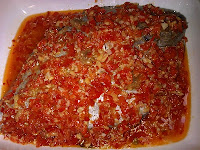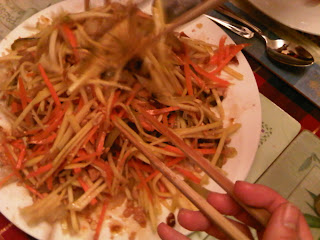Thinking about what we eat - I can now see why...
7.30pm - ‘Loh Sang’ salad
8.00pm - Grilled fish heads
BREAK (We’re pretty full at this point, and this is only the beginning)
9.00pm - Chilli crabs
9.45pm - Steamed crab shells
10.15pm - Baked pomfret with chilli pepper and fried noodles
ANOTHER BREAK (Walk, breathe)
11.15pm - Garlic and spring onion prawns
11.45pm - Pomelo and satsumas
 On the seventh day of Chinese New Year falls ‘Everybody’s Birthday’- a day in the Chinese calendar apparently more important than your own. Cue excessive eating back at the Lee family household. My mother has commissioned me to cook chilli crabs, and her school friends who also whip up some prime seafood (and whose grilled fish head dish makes its way onto this post).
On the seventh day of Chinese New Year falls ‘Everybody’s Birthday’- a day in the Chinese calendar apparently more important than your own. Cue excessive eating back at the Lee family household. My mother has commissioned me to cook chilli crabs, and her school friends who also whip up some prime seafood (and whose grilled fish head dish makes its way onto this post). I’m only posting recipes for Malaysian Chilli Crabs and Grilled Fish Heads, but special mention must go to the evening’s opening salad, the extraordinary ‘Loh Sang’ - which I’ve only ever seen Malaysian Chinese make. Everyone round the table must toss the ingredients - a variety of shredded vegetables, like carrot, fruit, pomelo, raw fish (symbolising life) and peanuts. A sweet dressing is poured over it, and everyone grabs their chopsticks and tosses the salad altogether. Permissible playing with food. We're beginning to enjoy ourselves.

Adding the dressing then mixing the salad.

Thinking of chilli crabs evokes outdoor restorans in the cool of a Kuala Lumpur evening - piles of crustacea lacquered with sauce, mucky hands grabbing the next leg, hearing the crack of teeth against shell and the satisfying sound of the suck of sweet crabmeat from the claw.
It’s such a wonderfully communal dish and there are infinite ways of making chilli crabs – but this particular recipe has been cooked countless times for hawkeyed Malaysians who leave not a scrap, which I guess is a good sign. I’ve experimented with brandy, extra tamarind, and even vermouth (big mistake) but the ingredient that makes the difference is actually lashings of Sriracha hot chilli sauce (discovered by accident when a friend up-ended a bottle into the wok). And when I didn’t have the chilli sauce, the understudy was ketchup, which worked as lickably well – both add a sweetness and depth that cut through the spices of the base paste.

And then fish heads. They provoke strange behaviour in the older generations.
Imagine you’re at dinner. You’re having a perfectly normal conversation about the demise of Cheryl and Ashley over a plate of whole fried fish, and all of a sudden, passionate spatting erupts, and chopstick-wielding parents and uncles fight over the fish head in the way teenage girls squabble over a spotty pubescent boy.
And I’ve noticed that whoever wins is silent for the next 15 minutes as they work to reach then savour every morsel of cartilagey goodness and soft meat and cheek that nestles in the head.
I realise this may not be to everyone’s taste, but I can say with a surety a fish head is an absolute treat as it yields so much flavour and tender meat. The Chinese talk about whether you ‘know how to eat’ something. Fish heads are something you have to ‘know how to eat’ because it’s a maze of bone which you expertly nibble around. My very English boyfriend does amazingly well amongst such seasoned cranium-eaters. But he can’t bring himself to eat the eyes. He’s still got a way to go.
And, as you can imagine, the heads are also terribly terribly cheap. I once went to Billingsgate market after 2 hours sleep (post-night- out). Marvelling at how little everything cost, I bought five huge salmon fish heads for £2.50 (as well as 3 lobsters, 5 cheeky crabs who terrorized my kitchen, 3 sea bass and 5 sea bream all for 35 quid. To say I got carried away is beyond understatement). Bargainous.
I wanted to post this fish head recipe – it’s so simple, so cheap, and such a tasty starter that I salute anyone brave enough to make it.

Grilled salmon fish heads
Serves 4
Ingredients
- 4 salmon fish heads, cut in half down the centre between the eyes (get your fishmonger to do this for you if you don’t have a sharp enough knife)
- Lots of salt
Recipe
Preheat grill to the highest temperature.
Wash the fish heads, and if there are still scales on them, give them a quick rub with a knife to take the scales off. Pat the heads dry with kitchen roll – the skin should be dry.
Salt the fish heads by rubbing the entire surface of the heads, skin-side and flesh side, with plenty of salt.
Place the heads on a wired baking tray, skin side up and put under the grill for about 15 minutes, or until the skin has JUST turned black. You want the skin to be a little blistered and blackened.
Take the baking tray out and turn the heads over so it’s flesh-side up.
Grill for another 5 minutes until the flesh is just cooked and still tender.
Serve immediately.

Chilli Crabs
Serves 4
You’ll need a good wok, or a deep frying pan
Ingredients
- 2 large live crabs. Buy on the day you want to cook them. You can keep them in the fridge in wet newspaper until you need to use them.
- Plain flour seasoned with salt and pepper
- Sunflower, vegetable or groundnut oil
- 1 teaspoon tamarind paste mixed with ¼ pint water and 1 teaspoon sugar
- 4 large squirts of Sriracha hot chilli sauce OR tomato ketchup and chopped fresh chillies
For the paste:
 - 1 stalk lemongrass
- 1 stalk lemongrass- 12 shallots
- 6 cloves garlic
- 4 cm ginger (or 2 cm galangal, 2cm ginger)
- 1 level teaspoon turmeric
- 1 teaspoon shrimp paste
- 10 birdseye dried chillies
Garnish:
- 2 spring onions finely sliced
- 2 sprigs coriander
Recipe
Chop all the ingredients for the paste. If you have the energy, forgo the gym and pound all the ingredients in a pestle and mortar. This seems to yield a better texture and taste. You can magimix the paste instead though - put all the ingredients in and whiz until an ochrey yellow paste. It won’t be smooth, but you want all the bits small enough so that there aren’t individual bits of lemongrass that get stuck in your teeth. Set aside.
Prepare the crabs.
Clean the crabs first under running water. An old toothbrush is best for a thorough scrub.
Place the crabs on a solid chopping board. Hold the crab on its back (shell side down) and stick a sharp knife into the crab directly behind the eyes to kill it.
Pull off the tail flap from the underside and discard. Then, either press down on the centre and legs and pull off the shell, or, if you’re having difficulty, insert the knife under the shell to give yourself some leverage.
Pull off the gills (dead man’s fingers) and throw away the spongy sand bag, which sits behind the eyes.
Using a sharp knife, cut the crab in half, and then cut off the claws. Use a mallet or rolling pin to bash each piece so that it’s easier for those eating to get to the meat.
Dip these parts (claws and legs) into the seasoned flour and make sure they are dusted all over.
 Heat about 200ml of oil in a wok or a deep pan. You know the oil’s hot enough when you stick a chopstick in and the oil furiously bubbles.
Heat about 200ml of oil in a wok or a deep pan. You know the oil’s hot enough when you stick a chopstick in and the oil furiously bubbles. Fry 4 pieces at a time, 2-3 minutes each side. The outside of the crab should be bright red and the flour crispy. If the oil turns brown at any point, use fresh oil.
Set the crab pieces aside on kitchen roll.
Heat the wok again. Using 2 tablespoons of fresh oil, fry the paste in the wok for about 2 minutes, until the spices smell amazingly fragrant. You do not want the paste to burn.
Add the tamarind-water-sugar mixture. Bring to the boil, then tip in the crabs back into the wok. Stir to make sure all of the crab is covered in sauce. Then cover the wok for about 5 minutes, giving the crabs a stir every now and then, so that they steam a little.
Open the wok, and add the ketchup and chillies/chilli sauce. Stir and cook for an extra minute.
Add the spring onions and coriander.
Stir once more, then serve.
If you’re at a loose end with the crab shells, which have the roe inside, you can either cook them the same way as the claws and legs, or you can steam them just as they are, and eat with a spoon. They are an acquired taste, but absolutely delicious.






